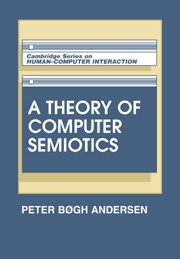 A Theory of Computer Semiotics
A Theory of Computer Semiotics Book contents
- Frontmatter
- Contents
- Preface to second edition
- PART I THEORY
- PART II COMPUTERS
- PART III LANGUAGE, WORK, AND DESIGN
- Introduction
- III.1 Language as interpretation. Semantic fields in the Postal Giro
- III.2 Language as action. Language games in the Postal Giro
- III.3 Task analysis. Controlling control.
- References
- Index
III.3 - Task analysis. Controlling control.
Published online by Cambridge University Press: 26 March 2010
- Frontmatter
- Contents
- Preface to second edition
- PART I THEORY
- PART II COMPUTERS
- PART III LANGUAGE, WORK, AND DESIGN
- Introduction
- III.1 Language as interpretation. Semantic fields in the Postal Giro
- III.2 Language as action. Language games in the Postal Giro
- III.3 Task analysis. Controlling control.
- References
- Index
Summary
In the preceding section, I showed how to use work and conversation patterns as a basis for design. In this last section I discuss principles for building these patterns into the system. What does it mean to “put work patterns into the system”? To what degree should it be done? How should it be done?
As my example I shall use the data entry parts of the data entry (registrering) process classified as control style in Section II.2.2.2. Here I noted that the PGP-system is in control in this part of the work process and guides the worker through a fixed standardized sequence of operations:
film number, transaction code, amount, account to, and account from
In addition, it automatically provides the next card of the same batch, and the first card of the next batch when the last of the previous batch is finished and the batch tallies. If it does not tally, it enters the completing subview. The system supervises the user's work, and directs the worker's attention to and from the screen by means of error messages like
Tyvärr, men det är fel kontrollsiffra för denna film.
[Sorry, but the control digit of this film is wrong]
VARNING: Denna bunt balanserar inte.
[Warning: this batch does not tally]
a type of control which was consciously introduced by the developers: they wanted to “stop a phase where you work with the card, and initiate a phase where you work with the screen”.
I have already classified this standardization of work as a “frozen” variant structure.
Information
- Type
- Chapter
- Information
- A Theory of Computer SemioticsSemiotic Approaches to Construction and Assessment of Computer Systems, pp. 425 - 432Publisher: Cambridge University PressPrint publication year: 1991